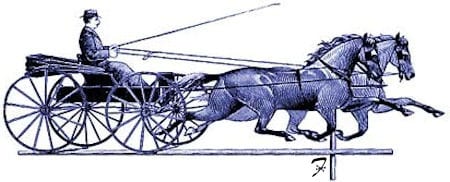
How do I read my weathervane? What makes it turn?
Do the weathervanes need to be assembled? Is it easy?
Why is a roof bracket not included in the price of copper weathervanes?
Do I need to have a cupola to install a weathervane?
Can a roof cap be used to mount a finial or weathervane?
Should my weathervane come down if a storm is on the way?
What is the difference between Machine Stamped and Hand-Sculpted weathervanes?
What is roof pitch?
Can I add an arrow to a weathervane if it is not shown with one?
Why don’t all weathervanes have arrows?
How long before the copper changes color?
Can the copper figures be painted?
Are wrought iron style weathervanes actually painted Aluminum?
What is included with the weathervane?
What does Copper, Bronze, Verdigris, and Gold Leaf mean in Pricing?
Are the weathervane figures three-dimensional or are they flat?
Is there anything that can be applied to the copper to prevent it from tarnishing?
What is the exact size of the weathervane figure? I see that in some cases only the length of the weathervane or arrow is listed.

